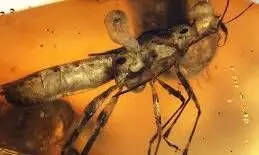
Rare dinosaur-era insect found in ancient amber
text_fieldsIsraeli scientists have unearthed a new species of flea preserved in amber from the mid-Cretaceous period when dinosaurs roamed the Earth.
This offers a captivating glimpse into a bygone era.
This flea, named Miropictopallium coloradmonens, displays vibrant hues, a departure from the usual muted tones seen in ancient insects trapped in amber.
Led by Dolav Fabrikant from the Hebrew University of Jerusalem and Tanya (Tatiana) Novoselsky from the Steinhardt Museum of Natural History at Tel Aviv University, the study revealing this remarkable find has been published in the Israel Journal of Entomology.
"This new insect enriches our comprehension of the present world by providing insights into a significant transitional era in the history of life on land. Its era was marked by a surge in biological diversity and the inception of what would become modern ecosystems," said Fabrikant.
Discovered within a piece of amber that surfaced at a public sale, the presence of Miropictopallium coloradmonens in Myanmar amber has sparked inquiries into its historical range and distribution, offering glimpses into prehistoric ecosystems.
During the mid-Cretaceous period, the Earth experienced a flourishing of insect diversity amidst hot and humid conditions. This period fostered the evolution of numerous species, including the colorful Miropictopallium coloradmonens.
Yet, as climates shifted and competition heightened, many of these species vanished, leaving behind traces preserved in amber for future study.
Amber, a fossilized tree resin, serves as an exceptional medium for preserving organisms due to its unique properties. Originating as resin exuded from certain trees, such as conifers, amber can trap small organisms like insects and spiders as it flows from the tree. Over time, the resin hardens into amber, preserving the enclosed organisms for millions of years.
"This newly discovered insect opens a fascinating chapter on flea evolution and offers fresh perspectives on life during the mid-Cretaceous period," concluded Novoselsky.























